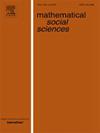Cooperation and balance in signed networks: A model of multiplex formation
IF 0.7
4区 经济学
Q4 ECONOMICS
引用次数: 0
Abstract
We propose a game theoretic model for multiplexity in signed networks through strategic interactions amongst players who are linked to each other in an existing signed network of friendships and enmities , which shape the incentive structure faced by players in their pairwise interactions with each other. These interactions take the form of simultaneous move cooperation games of complete information, wherein network effects create incentives to cooperate due to the presence of common friends as well common enemies. The set of pure strategy Nash equilibria in the strategic interactions between players and determine the nature of the tie between them in , which is the new layer of the signed multiplex. We investigate how properties of structural balance in the existing signed social network influence balance in the new signed network , identifying conditions on the existing network that yield a structurally balanced new layer of the multiplex.
签名网络中的合作与平衡:一个多元形成的模型
我们提出了签名网络中多重性的博弈论模型,通过在现有的友谊和敌人的签名网络中相互联系的n个参与者之间的战略互动,形成了参与者在彼此配对互动时所面临的激励结构。这些互动以完全信息同步移动合作游戏的形式出现,其中网络效应创造了合作动机,因为存在共同的朋友和敌人。参与者i和j之间的策略交互中的纯策略纳什均衡集决定了他们在G(G)中的联系性质,G(G)是有符号复用的新层。我们研究了现有签名社会网络g中结构平衡的性质如何影响新签名网络g (g)中的平衡,确定了现有网络上产生结构平衡的新多层的条件。
本文章由计算机程序翻译,如有差异,请以英文原文为准。
求助全文
约1分钟内获得全文
求助全文
来源期刊

Mathematical Social Sciences
数学-数学跨学科应用
CiteScore
1.30
自引率
0.00%
发文量
55
审稿时长
59 days
期刊介绍:
The international, interdisciplinary journal Mathematical Social Sciences publishes original research articles, survey papers, short notes and book reviews. The journal emphasizes the unity of mathematical modelling in economics, psychology, political sciences, sociology and other social sciences.
Topics of particular interest include the fundamental aspects of choice, information, and preferences (decision science) and of interaction (game theory and economic theory), the measurement of utility, welfare and inequality, the formal theories of justice and implementation, voting rules, cooperative games, fair division, cost allocation, bargaining, matching, social networks, and evolutionary and other dynamics models.
Papers published by the journal are mathematically rigorous but no bounds, from above or from below, limits their technical level. All mathematical techniques may be used. The articles should be self-contained and readable by social scientists trained in mathematics.
 求助内容:
求助内容: 应助结果提醒方式:
应助结果提醒方式:


